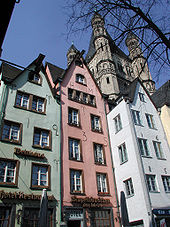Fish market (Cologne)
The fish market in Cologne is located between the beginning of the butter market at the level of the lower Lintgasse and the end of the Mauthgasse in the historic old town . The Romanesque church of Groß St. Martin is in the immediate vicinity .
History of the fish market
The first development on the fish market between Lintgasse and Mühlengasse dates back to 1100. These buildings are probably houses that were built on the site of what was then a Benedictine abbey , the Groß St. Martin monastery . An early medieval fish trade with open sales from so-called "karen" ( fish boxes ) also dragged on along the banks of the Rhine because of the storage of these boxes in the old town. The fish market was formerly connected to the main market at that time, the Alter Markt , through the lower Lintgasse . In connection with this trade, the fish market finds its earliest documented mention as a place name in the 12th century, it is called "forum piscium".
The market is establishing itself
The fish market has occupied the area between the choir of the church Groß St. Martin and the new medieval city wall on the banks of the Rhine since the 13th century . Now the name "upme Vischmarte" is used for it and in the 15th century it is called "up dem Vyschmarte". The developing fish trade in Cologne was promoted by the stacking right obtained in 1259 , the goods transported on the Rhine, including the fish mostly coming from Holland, had to be offered for sale to the citizens of Cologne for three days.
The trade in fresh so-called “green” fish was primarily carried out here. In Lintgasse the retail of found herring and salmon from the smoke instead, and on the north side of the Heumarktes the clientele in addition they offered kippers salt fish. Fresh river and Rhine fish were offered for sale at the fountain of the old market, the “Pütz”.
Feschmenger and Feschwiever
The stands at the respective locations of today's Old Town district, were to middlemen who Fesch Menger , leased. In general, the delivery and the sale to established banks took place, such as the Salmen benches on the south side of the fish market, where fresh or salted salmon was cut and sold. Smaller fish, as well as pond fish or crabs, were often sold in large numbers by women, the "Feschwievern". The high number of these fish stands is explained, as in our time, by supply and demand, after all, around 40,000 citizens lived in the city of Cologne around the middle of the 15th century. This type of trade and sale at the fish market continued over the entire time of the imperial city of Cologne.
Marché aux Poissons
It was not until the beginning of the 19th century that the fish market was briefly given the name “Marché aux Poissons” during the French rule. In the middle of the 19th century, the traditional way of selling fish on the street changed, too, with fish being sold in shops.
Today's fish market
The old town and with it the fish market were 90% destroyed in the last world war, as was the famous church of Groß St. Martin. It is thanks to committed city fathers and the city curators of the post-war years that many of the narrow, pointed-gable houses were rebuilt in the historical style. The "stacking house" at the fish market is one of the few structures that were only moderately damaged.
At the stack house
The unsatisfactory situation of the traffic flowing past between the old town and the banks of the Rhine with high intensity was tackled at the end of the 1970s and resolved by the creation of the Rhine bank tunnel after more than three years of construction. On November 5, 1982, the new underground road layout was put into operation. A “Rheingarten” was created between the Deutzer Bridge and the Hohenzollern Bridge , which connects the old town with the Rhine promenade.
Thanks to the newly gained area, all the historic streets and squares in the district benefit today, not just the fish market. All those involved, the gastronomy with its additional set-up options for tables and pavilions and thus better sales, as well as the visitors who are happy about the new "ambience" of the district, and the treasurer of the city of Cologne, who can book higher tax revenues from the increased number of visitors, have advantages.
Literature / sources
- Gerold Bönnen / Frank G. Hirschmann: Monasteries and monasteries from 1200 to the Reformation . Bonn 2006.
- Adam Wrede : Neuer Kölnischer Sprachschatz , first volume A - J , p. 215., Greven Verlag, Cologne, 9th edition 1984, ISBN 3-7743-0155-7
- ↑ Canon College (953-65); since 984–99: Benedictine
- ↑ Feschkar, Feschkaasch, perforated container or box for storing live, i.e. fresh, fish
Web links
Coordinates: 50 ° 56 '18.2 " N , 6 ° 57' 44.7" E









